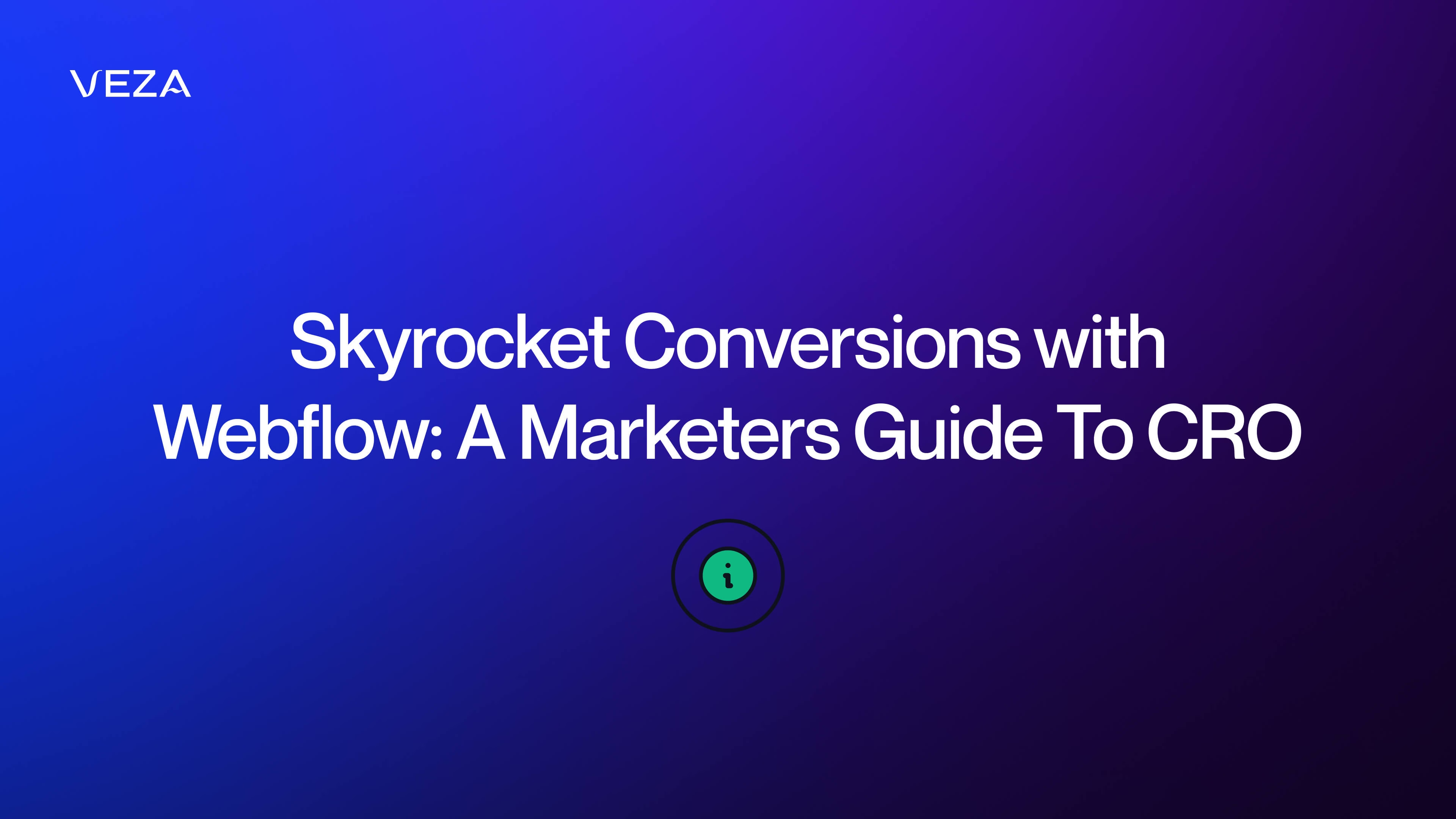Conversion Rate Optimization (CRO) is the systematic process of increasing the percentage of website visitors who take a desired action, such as purchasing, signing up for a newsletter, or filling out a contact form. With CRO, marketers can significantly boost a site's online presence, revenue, and growth when done effectively.
Webflow as a CRO Powerhouse
Webflow, with its visual design interface and CMS, is an excellent tool for implementing CRO strategies. It allows you to quickly test different design variations, personalize user experiences, and track key metrics to optimize your website for conversions.
Key CRO Strategies for Webflow
%252520(1).webp)
A/B Testing
A/B testing, or split testing, is a powerful marketing strategy that allows you to compare two versions of a marketing asset to determine which performs better. By systematically testing different variations, you can identify what resonates best with your audience and optimize your marketing efforts accordingly.
Headline Variations Experiment with different headlines to see which ones grab attention and drive clicks. Is a bold, direct headline more effective, or does a softer, more persuasive approach work better? You can determine which headlines get the highest click-through rates by testing various headlines.
Button Color and Placement, The color and placement of your call-to-action button can significantly impact user behavior. Test different button colors (e.g., red, green, blue) and placements (e.g., top right corner, bottom center) to identify the optimal combination for maximizing conversions. Image and Video Variations Visual content can greatly influence user engagement and conversions. Compare the impact of different images and videos on your audience. Does a product image or a video demonstration perform better? You can determine which visual elements drive the most desired actions by testing various visual elements.
Personalization
Personalization is a powerful marketing strategy that allows marketers to deliver tailored experiences to individual customers. By leveraging data and technology, marketers can create highly relevant and engaging interactions that resonate with each user.
One effective personalization technique is dynamic content. Marketers can use Webflow's CMS to create personalized content that adapts to a user's behavior, preferences, or demographics. This dynamic approach enables delivering content tailored to the individual, increasing engagement and conversion rates.
Another powerful personalization tool is targeted offers. By understanding a customer's needs and preferences, marketers can display relevant offers and promotions likely to pique their interest. This targeted approach increases the effectiveness of marketing campaigns and enhances the customer experience.
User Experience (UX) Optimization
User experience (UX) optimization is crucial for businesses to create a positive and lasting impression on their audience. By focusing on key elements such as mobile-first design, fast page load times, and intuitive navigation, marketers can significantly enhance the user experience and drive business growth.
Mobile-first design is essential in today's mobile-dominated world. By prioritizing the mobile experience, marketers can ensure a website is accessible and user-friendly on all devices. A well-designed mobile website improves user satisfaction and boosts search engine rankings.
Fast page load times are another critical factor in UX optimization. Slow-loading websites can frustrate users and lead to high bounce rates. Marketers can significantly reduce page load times and improve website performance by optimizing images, minimizing code, and leveraging browser caching.
Intuitive navigation is essential for guiding users seamlessly through a website. A clear and well-structured navigation menu allows users to find the information they need easily. By using clear and concise labels, logical hierarchies, and consistent design elements, marketers can create a user-friendly navigation experience that enhances user satisfaction.
Calls to Action (CTAs)
Calls to action (CTAs) are essential for guiding users toward desired actions, such as purchasing, signing up for a newsletter, or contacting customer support. Marketers can significantly improve conversion rates and overall website performance by implementing effective CTA strategies.
Prominent CTAs should be visually appealing and easy to find. By using contrasting colors, bold fonts, and strategic placement, marketers can draw attention to CTAs and encourage clicks. A well-designed CTA should stand out from the surrounding content and guide users towards the next step.
Strong action verbs are crucial for creating compelling CTAs. Instead of generic phrases like "click here," marketers should use strong action verbs that convey a sense of urgency and excitement. For example, using words like "Shop Now," "Learn More," or "Start Your Free Trial" can motivate users to take action.
Clearly, communicating the value proposition of a CTA is essential for encouraging clicks. By highlighting the benefits of taking the desired action, marketers can persuade users to take the next step. For example, a CTA for a free trial might emphasize the opportunity to experience the product or service without any risk.
Heatmaps & User Recordings
Heatmaps and user recordings are powerful tools that allow marketers to gain valuable insights into user behavior on their websites. By visualizing user interactions and analyzing their decision-making processes, marketers can identify areas for improvement and optimize their websites for maximum impact.
Heatmaps visually represent user activity on a website, highlighting areas that receive the most attention. Marketers can identify hotspots by analyzing heatmaps, such as popular buttons, links, and content sections. This information can help marketers optimize the layout and design of their website to guide users toward desired actions.
User recordings take heatmaps a step further by capturing actual user sessions. By watching recordings of user interactions, marketers can gain a deeper understanding of how users navigate their websites, what information they seek, and where they encounter obstacles. This valuable insight can help identify areas where the user experience can be improved, such as streamlining the checkout process, simplifying navigation, or enhancing product descriptions.
Landing Page Optimization
Landing page optimization directly impacts conversion rates. Marketers can create high-performing landing pages that drive results by focusing on clear and concise messaging, strong headlines and subheadlines, and relevant visuals.
A well-crafted landing page should have a clear message focusing on a single goal. Marketers can guide users toward the desired action by avoiding clutter and distractions. A single, focused message helps to maintain clarity and avoid confusing the user.
A strong headline and subheadline are essential for grabbing attention and enticing users to read further. A compelling headline should clearly communicate the landing page's value proposition, while the subheadline should provide additional context and entice users to take the next step.
Relevant visuals, such as high-quality images and videos, can significantly enhance the landing page experience. Visual content can help to break up text, make the page more engaging, and reinforce the message. Marketers can create a more immersive and impactful landing page by using relevant visuals.
Webflow’s Built-in Tools for CRO
Webflow offers powerful built-in tools to enhance your conversion rate optimization (CRO) efforts significantly. Marketers can create more effective, engaging websites that drive conversions and business growth.
One of the most valuable tools is Webflow's built-in A/B testing feature. This allows marketers to easily test different variations of their website, such as headlines, button colors, and page layouts. By comparing the performance of these variations, marketers can identify the most effective elements and optimize websites for maximum impact.
Webflow's CMS (Content Management System) is another powerful tool for CRO. Marketers can use the CMS to create personalized content and targeted landing pages that resonate with specific audience segments. This level of personalization can significantly improve user engagement and conversion rates.
Webflow's seamless integration with analytics tools like Google Analytics enables marketers to track key metrics and measure the impact of their CRO efforts. By analyzing data on website traffic, user behavior, and conversion rates, marketers can gain valuable insights into how users interact with their websites and identify areas for improvement.
Practical Tips for Marketers
Marketers must adopt a strategic and data-driven approach to optimize a website for maximum conversions. Start by setting clear and measurable goals for CRO efforts. Whether it's increasing sales, boosting lead generation, or improving website traffic, having well-defined objectives will help track progress and measure the success of your initiatives.
Data-driven decision-making is crucial for an effective CRO. Utilize analytics tools to identify areas of a website that may be underperforming. By analyzing user behavior, marketers can pinpoint bottlenecks, identify opportunities for improvement, and prioritize efforts.
A/B testing is a powerful technique for testing different variations of your website to determine which performs best. Marketers can make data-driven decisions that lead to significant improvements by continuously experimenting and analyzing the results.
Collaboration is key to a successful CRO. Work closely with your team, including designers, developers, and content creators, to identify opportunities for optimization and implement effective strategies. Marketers can create a more cohesive and user-friendly website by sharing insights and working together.
Finally, stay up-to-date with the latest trends and best practices in CRO. What works today may not work tomorrow. Marketers can ensure their CRO efforts remain effective and relevant by staying informed about the latest techniques and tools.
Let’s Work Together
Webflow's powerful features can significantly improve a website's conversion rate and achieve marketing goals. Let’s work together to get your sight seen and boost ROI. Contact Veza Digital today!


